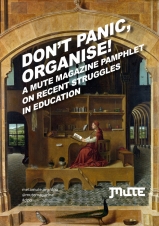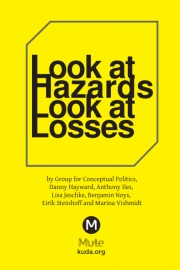Corporate Inhospitality
If its corporate context increasingly undermines art's critical status, the titling of a recent exhibition at Bloomberg – No, Future – suggests that the relationship between art and business may have already 'peaked', says Peter Suchin
No, future, so an unsigned statement in the brochure accompanying this show tells us, ‘takes its starting point in the idea of opposition… the stance or attitude that a work or an artist might take in relation to their environment or circumstances.’ And Sacha Craddock, one of the exhibition’s curators, remarks that the show ‘promises an investigation of a particular quality and ability in art which cannot directly oppose anything other than itself.’ With around thirty artists and about fifty works crammed into the inhospitable exhibition space that is Bloomberg’s European headquarters, it is virtually impossible to read No, future as much other than an unpleasantly cacophonous melange of would-be ‘political’ artworks. The muddled thinking behind the display is echoed in the irritating manner in which the works have been strewn together. In the foyer-cum-gallery at the front of the building the soundtracks from the several video monitors together form an irritating battery of screeches, the effect of which is to make the viewer desirous of removing him or herself from the building as soon as possible. The situation is hardly improved when one enters the rest of the exhibition, a spattering of pieces placed mainly around the edges of a narrow walkway from which one can peer down into an empty square, and up, high up into the spaces where the company’s employees go about their daily chores.

Image: Jordi Colomer, NO? FUTURE!, (2006), video, courtesy of the artist and Galerie Michel Rein, Paris
Further confusion comes in the form of a listing of artists and works printed in a manner extremely difficult to decipher, so that the map itself becomes another incentive to abandon the act of examining the show. In the back room the noise of drumming emanating from Jordi Colomer’s No?Future!, a video from 2006, dominates everything else; you soon begin to suspect that the whole thing is a structure specifically designed to torture the company’s staff. No wonder then that a sign above the desk giving information about how to contact the Samaritans became, for myself and other viewers, a comic, highly pertinent notice. It wasn’t marked on the chart, nor could the staff inform me who had placed it there or why. Apparently the curators didn’t know who the culprit was either, but there it was, a clever little jest enacted upon the unsuspecting Bloombergians by an unnamed contributor with a wry sense of humour.
Image: Franck Scurti, What is Public Sculpture? #4, (2007), steel and painted aluminium, 250x150x100cm, courtesy of the artist and Galerie Anne de Villepoix, Paris
A graffiti-impregnated structure of twisted metal turned out to be Franck Scurti’s What is Public Sculpture? # 4 (2007), the title of which is drably ironic, the graffiti having been supplied as an intrinsic part of the piece. Rafel G Bianchi’s large fibreglass figure bearing a ‘don’t ask me, I haven’t a clue!’ expression, again relied somewhat directly on its title – Don’t ask the ignoramus (2005) – for effect, yet it did seem to be mocking, aptly, slyly, the very exhibition in which it had been placed. A few other inclusions worthy of greater attention than that encouraged in the present case, were apparent, but the aforementioned din determined that one head for the exit sooner rather than later. How could one attend with any seriousness to Mark McGowan’s The Re-enactment of the Piccadilly Line Tube Bombing (2007), a short video piece whose semi-absurdist stance might have encouraged some interesting thoughts about the recursive, self-serving operations of the British media had its soundtrack been clearly audible? Its self-defeating (or in any case inwardly looping) theme was shared by many works in the exhibition, a position Craddock is presumably alluding to in the remark quoted above, but this somewhat flaccid thematics had inappropriately escaped from the work into the very fabric of the exhibition, to the point at which, once one had grasped that this was what the show was ‘about’, one had little need of the pieces themselves. The bland self-negation of these works remained constrained by the formulaic, insubstantial curatorial pose, the overall effect being not so much one of revealing variations on a theme, as showing up just how weedy an ‘issue’, political or otherwise, it was.

Image: Rafel G. Bianchi, Don’t ask the ignoramus, (2005), polychrome fiberglass, 189x95cm, courtesy of the artist and Galerĺa Nogueras Blanchard, Barcelona
Bloomberg SPACE is an awful venue in which to present works of art. The company’s own technological props and snazzy glass floors leave one wondering just where the art starts and stops, the mood being one of disorientation, as opposed to seduction or intrigue.
Ignasi Aballi’s collections of paint containers whose contents had gone sour recalled the abandoned detritus of the decorator, looking like they should be cleared away. This incongruity, paradoxically, was of the kind that worked well in the icy atmosphere of Bloomberg, pointing to the reality of construction and production, whereas the majority of the other pieces on show were easily subsumed by the corporate ambience. In the brochure there is some discussion of how art cannot effect political change, but what is lacking is any reference to how work can be neutered by placing in a corporate context. The overarching problem with No, future is corporate culture’s relation to art, not art per se, and this regardless of the widely varying quality of the pieces chosen for this show.

Image: Ignasi Aballí, Waste, (2001), mixed media, various dimensions, courtesy of the artist and Cal Cego Collecciớ d’Art Contemporani, Barcelona
Anna Fasshauer’s Casino Royale (2002), a table bearing around 200 cardboard-mounted newspaper photographs, each of which had a hinged element – a swinging arm or leg, or a moving mouth – seemed to sum up Bloomberg’s attitude to artists, and the reason the company is so keen to have them in the house: they, or at least the things they make, can be manipulated like puppets, perhaps all the more so when they claim for themselves (like the figures in Fasshauer’s work) political status. This, very unfortunately, is the central, if inadvertent, theme of No, future, an exhibition whose main achievement appears to be the emasculation of the work of which it is comprised.
 Image: Anna Fasshauer, Casino Royale, (2002), wood, card, press cuttings, felt and bulb, courtesy of the artist
Image: Anna Fasshauer, Casino Royale, (2002), wood, card, press cuttings, felt and bulb, courtesy of the artist
Peter Suchin <petersuchin AT yahoo.co.uk> is an artist and critic. He has contributed to Frieze, Art Monthly, Variant, Untitled and many other journals
Info
No, future was at Bloomberg SPACE, London, 29 September – 10 November, 2007
This text was originally commissioned by Untitled magazine
Mute Books Orders
For Mute Books distribution contact Anagram Books
contact@anagrambooks.com
For online purchases visit anagrambooks.com







